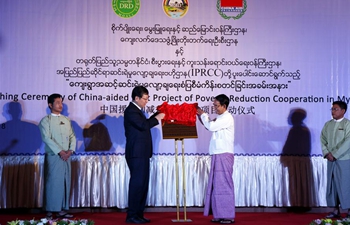WUHAN, Feb. 2 (Xinhua) -- When Wang Wenfeng, a PhD candidate in central China's Hubei Province, undertook his research into microplastics he did not expect British Prime Minister Theresa May to draw attention to his work.
Studying at Wuhan Botanical Garden of the Chinese Academy of Sciences in Wuhan, capital of the province, Wang, 29, met the British Prime Minister on Wednesday, the first day of her three-day official visit to the country.
She talked with Chinese scholars during her stay in Wuhan, and Wang was among them.
"I introduced my studies and findings to her in English. The prime minister listened carefully and said microplastic pollution is a global concern," Wang said.
Microplastics, which come from cosmetics, clothing and diverse sources, are small plastic particles less than 5 mm in diameter. Microplastics are considered an emerging water pollutant and have raised concern across the world.
About 300 million tonnes of plastic is produced every year across the world. Plastic products are hard to degrade and can exist for centuries. An estimated 35,000 tonnes of microplastics enter the oceans every year.
"There are a small number of Chinese scholars studying microplastic pollution in China and the studies just started recently" Wang said."Microplastic pollution is my dissertation topic. It is not easy to conduct research as there is a lack of Chinese literature. I have to read many English books and articles for reference."
British universities are leading research into microplastic pollution in the ocean. However, most research of microplastics conducted by Chinese and foreign scholars is based on the marine environment.
Research about microplastic pollution in inland freshwater is lacking.
Wang and his team carried out research in freshwater by innovating and updating technologies over the past years. They successfully obtained information about microplastic pollution in lakes in Wuhan and the Three Gorges Reservoir area.
Wang's research detected the microplastic concentration in waters of Wuhan, one of the largest cities along the Yangtze River, and found that the major type of microplastics in the studied waters was colored plastic, with fiber being the most frequent.
Most microplastic pollutants came from waste water discharged by those living along the banks of the section in Wuhan and the upper reaches of the Yangtze River, according to Wang's research.
"We provided important information about microplastic pollution in freshwater for the world," Wang said.
Most of Wang's team members are young people born in the 1980s. There are also students from African countries, where less research about microplastics has been conducted.
"They hope to take those research achievements back to their own country," Wang said.
China has stressed protecting the ecology of the the Yangtze River economic belt, since the 18th National Congress of the Communist Party of China in 2012.
Provinces and cities along the Yangtze River have made a series of efforts to protect water resources, reduce water pollution and restore water ecology.
Wang said the accuracy of microplastic detection would be increased.People's awareness of microplastics should be raised, and the government should consider laws to tackle microplastic pollution.
Scientists in Britain and other developed countries have called for a worldwide ban on some microplastic-containing products.

















